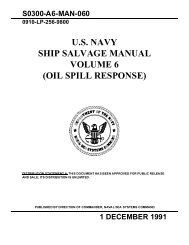Gallon JP-5 Spill at Naval Station Roosevelt Roads - Supervisor of ...
Gallon JP-5 Spill at Naval Station Roosevelt Roads - Supervisor of ...
Gallon JP-5 Spill at Naval Station Roosevelt Roads - Supervisor of ...
Create successful ePaper yourself
Turn your PDF publications into a flip-book with our unique Google optimized e-Paper software.
Winter 1999/200012Pacific & West Coast NOSCsConduct WCD PREP ExercisesIn October 1999, COMNAVREG (CNR)Hawaii conducted its Worst Case Discharge(WCD) drill, fulfilling the threeyearPREP exercise requirement. In additionto putting the CNR Hawaii <strong>Spill</strong> ManagementTeam through its paces, components<strong>of</strong> the Military Sealift Command(MSC) actively particip<strong>at</strong>ed in the drill.The October Hawaii drill represents thefirst time th<strong>at</strong> MSC exercised its completespill response procedures, activ<strong>at</strong>ing variousMSC command components rangingfrom headquarters in Washington, DC, tothe local Pacific command. Additionally,MSC drilled various coordin<strong>at</strong>ion issuesbetween the particip<strong>at</strong>ing vessel (USNSEricson [T-AO 194]), MSC commands,and the Navy NOSC.Two particular issues th<strong>at</strong> have beendifficult areas to approach were addressedduring this exercise—funding(e.g., wh<strong>at</strong> command pays for a spill involvinga MSC vessel) and jurisdiction(between MSC the NOSC and the USCG).Valuable lessons were learned in ironingout these issues, lessons which benefitall NOSCs in the event <strong>of</strong> a spill from aMSC vessel.Because Pearl Harbor is used almostexclusively by the Navy, the Federal On-Scene Coordin<strong>at</strong>or (FOSC) gave theNavy considerable l<strong>at</strong>itude in decisionson issues for which the FOSC normallyhas ultim<strong>at</strong>e authority, such as closing theharbor to all vessel traffic and movingthe damaged vessel.Once again, the drill underscored theimportance <strong>of</strong> training. CNR Hawaii <strong>of</strong>feredits response personnel extensivetraining opportunities. For those whotook advantage <strong>of</strong> the training, it showed;for those who did not take advantage <strong>of</strong>the training, it showed.As with all exercises <strong>of</strong> this n<strong>at</strong>ure, thereal benefit is derived from the interactionwith responders from other organiz<strong>at</strong>ionsand the value <strong>of</strong> experiencing conditionssimilar to th<strong>at</strong> <strong>of</strong> an actual spill,but conducted in a training environment.Earlier this year in March 1999,COMNAVREG Northwest (CNR-NW)conducted a similar WCD exercise. TheCNR-NW drill was scheduled as a twodayexercise. During the drill CNR-NWexperienced a generous dose <strong>of</strong> actual adversewe<strong>at</strong>her conditions. During theevening <strong>of</strong> the first day <strong>of</strong> the drill, arogue Pacific storm came through the area,and the command center lost all power forits second day <strong>of</strong> the drill. CNR-NWA chart is an essential tool during spill responses. NOSCrepresent<strong>at</strong>ive Paul Teasely discusses response str<strong>at</strong>egywith the team.Following the exercise each section g<strong>at</strong>hers to discuss theresponse.Continued on page 13
















